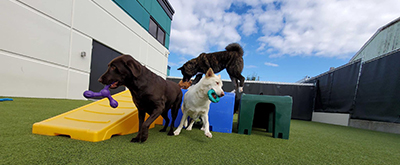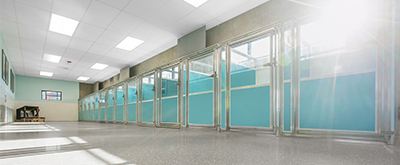Leash Reactivity
Leash reactivity, another form of barrier frustration, is common among dogs. Leash reactivity happens when dogs experience increased anxiety at the sight of something they want to get to (but cannot get too due to the leash) in their environment - this can include other dogs, people, squirrels, cars, etc. Typical signs of leash reactivity include barking, pulling, whining, and lunging toward the thing they want to get to while on a leash.
Not all dogs experience leash reactivity but for those that do, dog training exercises can help! It is important to note that any implemented dog training exercises need to be practiced consistently to help alleviate reactivity. As always, it is recommended that you work with a professional dog trainer, as they can help with guidance, technique, and consistency.
Training and Socialization
Proper training and socialization are essential to reducing leash reactivity. This training can, and should, include working on better communication with your dog so you can see when their anxiety is increasing. If you can see when your dog's anxiety is increasing then you can remove them from situations before they get overstimulated.
Counterconditioning and Desensitization
Counterconditioning helps your dog to associate positive stimuli within their environment. This includes certain people and even other dogs. Counterconditioning also allows the chance to practice positive reinforcement training techniques. Creating an association between a treat or a toy (something good) and other dogs or people (the thing that causes anxiety) will help to significantly reduce leash reactivity. The most important thing is to start slowing and go at the dog's own pace. You will need to start at a distance where your dog is comfortable in order for this technique to be successful.
Desensitization involves slowly introducing your dog to stimuli within their environment but in a controlled and safe manner. This allows your dog to slowly adjust to the stimuli to help reduce unwanted behaviors that stem from fear and anxiety. The key to desensitization is to be consistent and start slow.
Safety and Equipment
Providing the proper equipment and keeping safety in mind while walking your reactive dog are paramount. Remember to always keep your dog on leash if you are not in a designated "off leash" area. Long lines can be purchased and attached to your dog's harness to give them more space while not letting them off leash - just be aware of your surroundings so your dog does not have the opportunity to get too close to a strange person, dog, or car. If you must take your dog on walks, but you are worried about your dog potentially biting someone, talk to your trainer about getting your dog (and desensitizing them to) a properly fitted basket muzzle. While training, a front clip harness may provide better handling and control and reduce your dog's ability to lunge and pull while on walks.
As always, talk to a professional dog trainer about options available for your dog. As mentioned before, consistency and going at your dog's own pace are key when working on reactivity. Professional dog trainers at Biscuits Doggie Daycare and Pet Resort do not work hands-on with reactive dogs but can give you advice and help guide you in the right direction!



